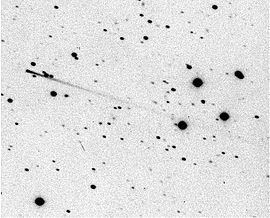Alternative names P/1996 N21979 OW7 Discovered 14 July 1996 Asteroid group Asteroid belt | Observation arc 13350 days (36.55 yr) Orbits Sun | |
 | ||
Discovered by 1979 OW7:M. R. S. HawkinsR. H. McNaught, S. J. Bus 1996 N2:Eric W. Elst, Guido Pizarro Discovery date 24 July 1979 (1979 OW7) 14 July 1996 (1996 N2) Minor planet category Main-belt comet Main-belt asteroid Themis/ Beagle family Aphelion 3.66751 AU (548.652 Gm) (Q) Discoverers Schelte J. Bus, Guido Pizarro, Robert H. McNaught, Eric Walter Elst Robert H. McNaught discoveries C/2009 R1, C/2006 P1, C/2013 A1, 5335 Damocles | ||
Comet Elst–Pizarro is a body that displays characteristics of both asteroids and comets, and is the prototype of main-belt comets. Its orbit keeps it within the asteroid belt, yet it displayed a dust tail like a comet while near perihelion in 1996, 2001, and 2007.
Elst–Pizarro was reported in 1979 as minor planet 1979 OW7, with its image on a photographic plate being completely stellar in appearance. Its orbit remains entirely within the orbits of Mars and Jupiter, with eccentricity 0.165, typical of a minor planet in the asteroid belt. However, the images taken by Eric W. Elst and Guido Pizarro in 1996, when it was near perihelion, clearly show a cometary tail. Since this is not normal behaviour for asteroids, it is suspected that Elst–Pizarro has a different, probably icy, composition. The cometary nature of Elst–Pizarro was first discovered when a linear dust feature was observed with the ESO 1-metre Schmidt telescope at La Silla Observatory on 7 August 1996.
Subsequently, around the next perihelion in November 2001, the cometary activity appeared again, and persisted for 5 months.
At present, there are only four other objects that are cross-listed as both comets and asteroids: 2060 Chiron (95P/Chiron), 4015 Wilson–Harrington (107P/Wilson-Harrington), 60558 Echeclus (174P/Echeclus), and 118401 LINEAR (176P/LINEAR, previously 1999 RE70). As a dual status object, astrometric observations of 7968 Elst–Pizarro should be reported under the minor planet designation.
It most recently came to perihelion on 8 February 2013.
